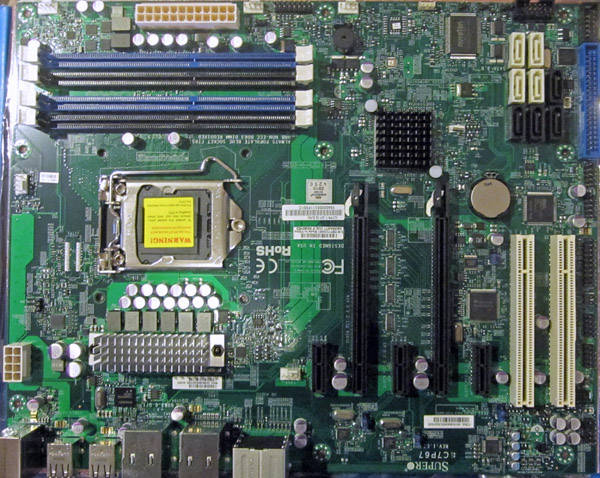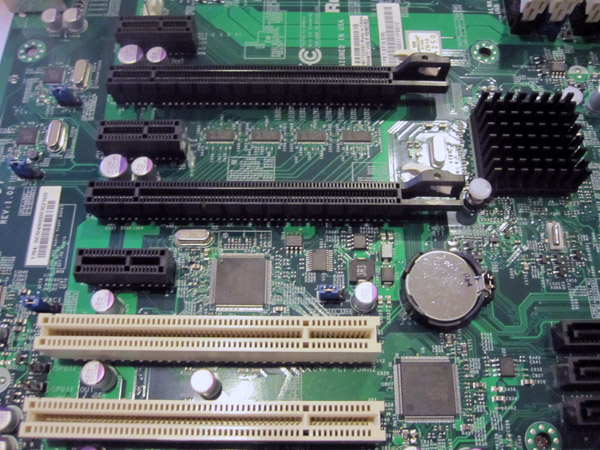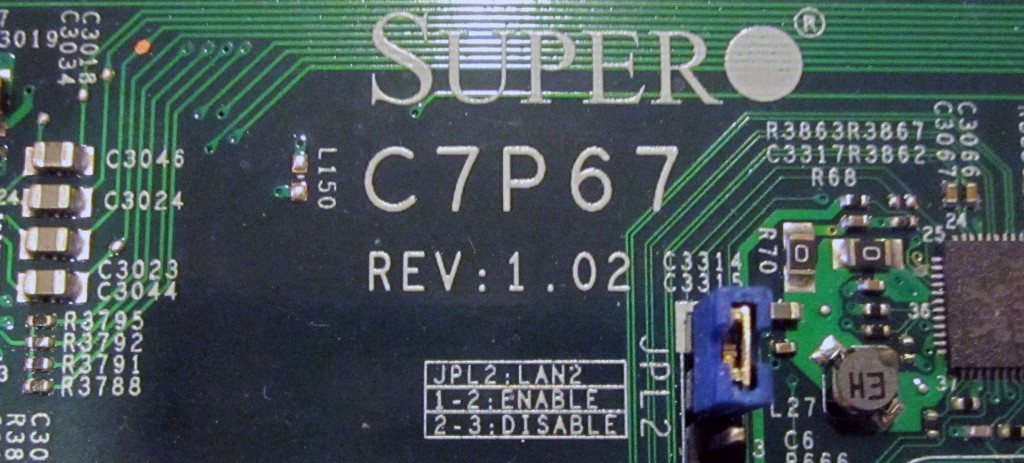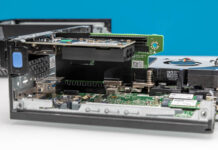Supermicro is well known for producing solid server motherboards, chassis, peripheral cards, and accessories. At the relatively lower-end of the market are uni-processor (UP) servers and workstations. Unlike dual and quad processor systems that oftentimes require specialized platforms, UP servers can tend to be very similar to higher-end consumer platforms. For example, Intel’s 5-series consumer chip sets were very similar to the 3400 series server chip sets, and in-fact, one could put a LGA 1156 Core i3-530 into a Intel 3400 series motherboard like the Supermicro X8SIL-F. Likewise, for a period of time I used an old Core i7 920 (later replaced by a Xeon W3550) in a Supermicro X8ST3-F which was basically the server version of a consumer X58 platform. As we have seen on this site, the next-generation Sandy Bridge Xeons such as the E3-1230 work in H67 consumer motherboards. Supermicro has taken its knowledge of UP server platforms and adapted it to the consumer market for Intel Sandy bridge platforms and has a new consumer offering, the C7P67 motherboard based on the P67 chip set.
Test Configuration
This setup is probably a reasonable Sandy Bridge consumer setup with a discrete video card, easy to use and quiet water cooling and the currently top-end Sandy Bridge part.
- CPU: Intel Core i7-2600K
- Motherboard: Supermicro C7P67
- Cooling: Corsair H50
- Memory: 2x Corsair Vengeance 1600MHz C9 4GB DIMMs
- OS Drive: Corsair Performance 3 Series P3-128 120GB SSD
- GPUs: EVGA GTS 450
- Enclosure: Antec Nine Hundred
- Power Supply: Seasonic X750, 750w power supply
I would probably argue that this board probably caters more towards an Intel Core i5-2500K market or a fixed multiplier part just because the Core i7-2600K is more of an enthusiast part where a setup featuring things like quad-SLI might be desirable.
Board Layout
When many people think about consumer and small business oriented system motherboards, they often think of the highly stylized overclocking and gaming motherboards with brand defining color schemes, many LEDs, large heat sinks and names that often resemble text from graphic war novels. Although that is an exciting part of the consumer market to cover from a review perspective, the fact is that in an office environment, opening a PC to see a MSI motherboard with a “KillerNIC” or a ASUS Rampage, or Foxconn Bloodrage would be somewhat out of place. Instead of going that route, Supermicro produced a traditional green PCB ATX motherboard design with popular features.

Expansion slots are provided from top to bottom in an x1, x16, x1, x16, x1 PCIe configuration with two legacy PCI slots occupying the bottom expansion slot positions. Having the first slot be a PCIe x1 slot is a best practice at this point as it allows for larger coolers to be used with more room around the CPU area.

The SATA ports are all perpendicular to the motherboard plane. Black connectors are for SATA II 3.0gbps ports and white connectors are for SATA III 6.0gbps ports. Supermicro sources the four SATA II ports from the Intel P67 PCH along with two SATA III ports. The other two SATA III ports utilize a Marvell 88SE9128 controller. One potential area for improvement is to change the color of either the Marvell or Intel SATA III 6.0gbps ports as it is hard to distinguish one set from another. Reading the screened print on the motherboard or the manual will quickly clarify this, but it would likely help a technician at an IT help desk save a few seconds. A legacy IDE port rounds out the drive connectivity options.

The rear I/O panel has eight USB 2.0 ports and two USB 3.0 ports to round-out USB expansion. One nice feature is that all of the USB ports are double stacked immediately above the motherboard’s PCB plane making it consistent for a user connecting a rear panel USB device by reaching around the chassis. Some other boards mix USB and other ports in these bottom positions which makes it harder to find an open and correct slot while not looking directly at the rear I/O panel. Audio is provided by five analog ports and a S/PDIF optical port powered by the RealTek ALC889 codec. Two gigabit LAN ports can be found on the rear panel. Finally, a combo PS/2 mouse and keyboard port is available. I was a bit surprised that there was no eSATA connector, but one can easily use a converter bracket to convert an internal port to an eSATA port. Also, adding an eSATA port on the P67 platform generally means either losing an internal SATA header or adding another SATA controller, adding to the board’s BOM costs considerably.
Features
The Supermicro C7P67 features dual Realtek RTL8111E gigabit LAN controllers. With a best practice for storage servers being to keep the storage servers on a different network than internet traffic, a consumer or business user’s desktop PC can connect simultaneously to both a dedicated storage network as well as a second network for internet traffic. Doing so allows an individual or organization to support storage related networking features on one network that may not be desirable on a general purpose network. For example, jumbo frames often increase throughput to and from storage servers but can have a negative impact on latency important for video communication and gaming.
For its Cougar Point implementation, Supermicro has opted for a BIOS that looks much like traditional BIOSes and behaves the same way using a keyboard. Supermicro does enable 3TB hard drive support however that is probably not the most interesting feature. If one has an Intel K series Sandy Bridge CPU (currently the Core i5-2500K and i7-2600K) there is a BIOS setting allowing the user to change multipliers. I was able to take my Core i7 2600K to 4.0GHz using the multiplier manipulation feature.
One often overlooked feature, which I think should be standard at this point, is the inclusion of 4-pin Pulse Width Modulated (PWM) fan headers. The Supermicro C7P67 includes four PWM fan headers which allow for CPU coolers, such as the stock Intel LGA 1155 heat sink and fan assemblies to be both monitored and controlled through software applications or motherboard logic. The net result is that the PWM fans can spin up and down according to load which both quiets a system and keeps power consumption slightly lower.
Supermicro also follows the leading practice of using all solid capacitors on the C7P67. This removes the risk of a cracked capacitor spilling onto the motherboard and is generally a good design choice.

One other feature that I found to be especially nice was the ability to turn off almost every, if not every onboard peripheral through the use of jumpers. If one will not be using a device, the user can change jumper positions and manually turn off an onboard device which is useful for troubleshooting problems.
Conclusion
Overall, the C7P67 caters to the desktop P67 market and offers some desirable features. First, it offers dual gigabit ports which a lot of other sub-$200 P67 motherboards lack. Second, and this is unusual for a Supermicro motherboard, it actually can overclock K-series CPUs which basically gives the user “free” performance boosts if the user chooses to take advantage of this feature alongside an appropriate CPU. With that being said, the C7P67 was not designed to be the best overclocking motherboard ever. It is instead designed to be a well rounded board that can be deployed in the consumer and small business segments. To that end, the C7P67 delivers a strong value proposition.




I have this MB for Photoshop and other CAD stuff running a i5 2500K, hoping it will last for a very long time, but then again, it’s a Supermicro, so it will.
What is the replacement for this board? I’m hoping they make one with the 77 chipset. The C7B75 has the B75 which does not have very many features.
This is NOT a Sandy Bridge Configuration!!!
It is an IVY Bridge!!!
It is now 2020 and this MB is still running strong as is the video card, the only change was the HD’s to SSD’s.